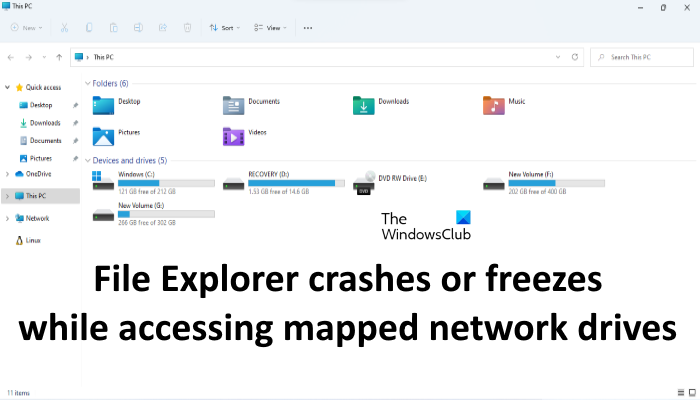Explorer crashes or freezes while accessing Mapped Network Drives
The following solutions may help you fix the issue: Let’s see all these solutions in detail.
1] Unpin everything from Quick Access
We can pin files and folders to the Quick Access menu. This allows us to access such files and folders quickly. But pinning files and folders to Quick Access sometimes causes the File Explorer to hang or freeze. Hence, if you have pinned anything to Quick Access, remove it and see if it brings any changes.
2] Set File Explorer to open to This PC instead of Quick Access
You may also experience this issue if the File Explorer opens to Quick Access by default. Set File Explorer to open to This PC instead of Quick Access and see if it fixes the issue. The steps to do this are as follows: Read: File Explorer crashes or freezes when creating New folder.
3] Turn off Thumbnails Preview in File Explorer
Among the affected users, some have explained that the issue was fixed when they disabled the Thumbnail Preview in File Explorer. You should also try this.
4] Clear the File Explorer’s history
You can also try to clear the history of File Explorer. This action clears the search history and the list of all files and folders that you have opened in File Explorer. In addition to this, deleting the File Explorer history also clears the cache. Hence, it also fixes the problems that arise due to the corrupted cache.
5] Disable Windows Search Service
If the above methods did not fix your issue, disabling the Windows Search service may help. To do this, follow the steps below: After disabling the Windows Search Services, check if the issue still persists. Read: How to enable or disable SMB1.
6] Create a new Value in Windows Registry
Another method to fix this issue is to create a new Value in Windows Registry. We have listed the instructions for this below. But before you proceed, it is better if you create a backup of the Registry so that you can restore it if any problem occurs.
1] Press Win + R hotkeys to launch the Run command box. Type regedit and click OK. Click Yes if you receive a UAC prompt message. 2] In the Registry Editor, copy the following path, paste it into its address bar, and hit Enter: 3] Make sure that you have selected the NetworkProvider key on the left side. Now, right-click on the right side and go to “New > DWORD (32-bit) Value.” Name this newly created Value RestoreConnection. Now, double-click on it and set its Value Data to 0. This has helped many. TIP:
This has also been known to help some. Add the registry key ProviderFlags as a REG_DWORD with a value of 1 (0x00000001) to HKEY_CURRENT_USER\Network*SMBv1 Drive Letter</code<> Then reboot the computer and see.Yet another suggestion that has helped some is to navigate to HKEY_LOCAL_MACHINE\SYSTEM\CurrentControlSet\Services\Tcpip6\Parameters and create a DWORD DisabledComponents with value 00000020.
7] Disable Fast Startup
Fast Startup is a feature in Windows 11/10 computers that decreases the bootup time in order to start Windows quicker than the normal mode. Sometimes, it creates issues with Windows OS. You can disable the Fast Startup feature. It should help.
How do I fix File Explorer crashes or freezes in Windows 10?
If File Explorer crashes or freezes on your Windows computer, you can try some general solutions given in the linked post. You can disable the Preview Pane, disable the Thumbnails Preview, run SFC scan, update your display drivers, etc.
How to fix Can’t reconnect to all network drives
When Windows is unable to reconnect all network drives, it displays the following error message:
Such an error occurs when the Netlogon service is disabled. Hence, to fix this error, you have to enable this service on Windows OS. The steps for the same are listed below: Hope this article helped you fix the error. Read next: Windows File Explorer crashes when I right-click to open Context Menu.

